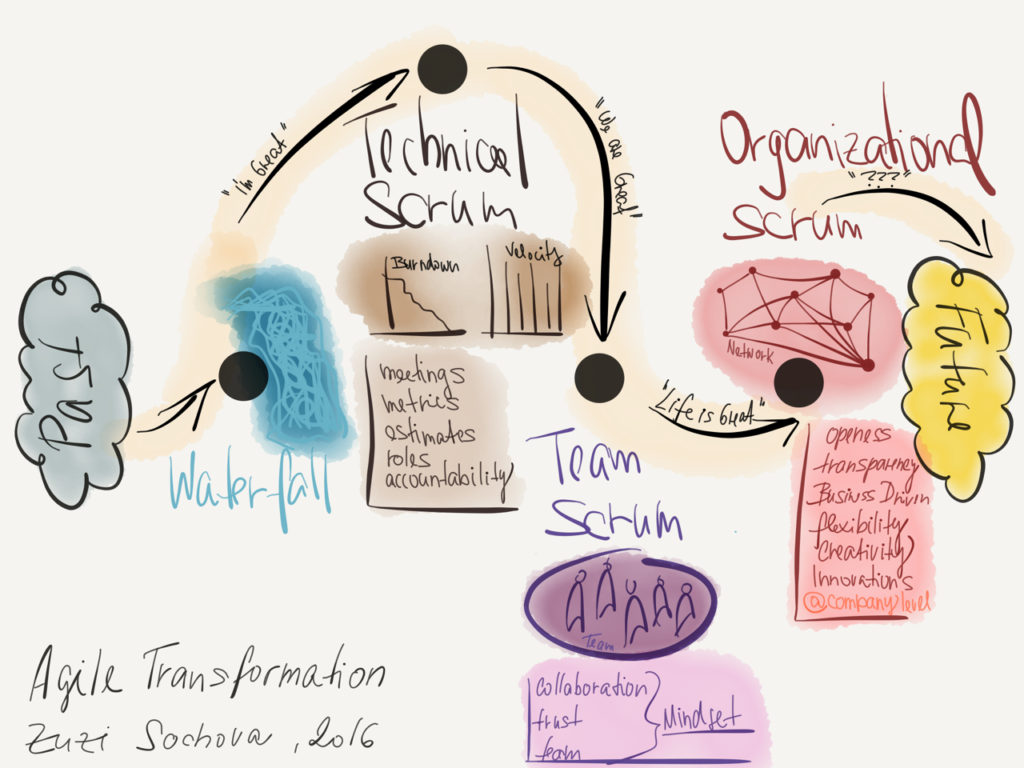As one of the CSTs – Certified Scrum Trainers – I’ve got a unique opportunity to travel around the world during the last two years and teach Scrum at a variety of businesses, organizational environments, and very different cultures. I must admit that Scrum is awesome as it is universal. You can apply it to software, hardware, marketing, HR, executive teams and be rapidly successful, significantly better, change the way of work and become the best of the greatest. The flip side of the coin is, that despite the easy way how Scrum is defined, there are still companies, teams and individuals completely failing to understand what Scrum is and therefore failing to implement it.
I draw this picture to illustrate that becoming Scrum is a journey. You can’t just do Scrum, you have to embrace it. You have to become Scrum yourself first. It’s often not that straightforward as we’ve been got used to the traditional processes throughout the history, but at the same time, this is the very best strength of Scrum. Once you master it, it becomes the part of your life. It’s not just a process, it is a way of living.

Technical Scrum
First, let me say explicitly that “Technical Scrum” is not Scrum. It only pretends to be Scrum. It’s a camouflage. However, it might be the necessary first step in certain organizations to move to the real Scrum. How do you recognize Technical Scrum? People “do” Scrum. They are looking for ways how to remain the same as they used to be. They are eager to get checklists of practices which need to be done, in order to do proper Scrum. Therefore Technical Scrum is all about estimations techniques, burn-downs, measuring velocity. The very important metric would be individual utilization, so they usually insist on time task estimates, capacity calculations, and time-sheets to be filled. They have identified new roles, but in reality, they just renamed the traditional roles and didn’t change the behavior. Scrum meetings are usually long and felt redundant. Managers use Scrum to micromanage. The overall team focus is on “how”. The team is not any team but a group of individuals working on similar items. The individual accountability matters. They are looking how to split responsibilities instead of how to collaborate to achieve the goal. Product Backlog is usually a to-do list where most things have to be done.
Scrum Mindset
In the real Scrum, your team understands the mindset and they are “living” Scrum. They take it as the way how to focus on customers, how to innovate, how to collaborate. The estimates, efficiency, and utilization become quite unimportant, as they focus on delivering value to the customer and overall long term results. The first step here is usually “Team Scrum” where the development team becomes a real self-organized and cross-functional team which works together. The team creation process produces a huge trust internally among the team members but also externally to the organization. It’s the first tiny ‘snowball’ which afterward starts the whole transformation and creates forces to change how we run our business and how the organization itself is structured.
The “Organizational Scrum” builds on top of the values we experienced at team level – openness, transparency, and trust which leads the organization to be more business driven, flexible, and open to innovations. The business slowly starts to be picking up and the organization has to follow the rest. At this time, the snowball is big enough to attract the rest of the organization. At that time, you are truly Agile.
Such transformation can take years. It’s not uncommon that companies are falling back and restarting the whole initiative again. It’s hard. To succeed you need a good reason for change and courage. Eventually, every company has to change as the word is getting more complex and fast. The same way as industry revolution changed the way we were hundred years ago, the complexity of our current life is changing us now. To succeed in a long term, we have to be more flexible and dynamic – more Agile.
APPENDIX: Top Agile Experts
(as many people ask about who to hire for agile transformation and the quality of Agile Coaches, here is a short paragraph about this)
There are generally two groups of experts in the Agile world. Trainers and Coaches. Each group focus on the same field but from a different angle. The most recognized are Certified Scrum Trainers® (CST) and Certified Enterprise Coaches (CEC) both linked with Scrum Alliance. Both groups represented top world experts which are proved by highly prestige certifications issued by Scrum Alliance.
The CST – Certified Scrum Trainers deliver the certification training such as CSM – Certified ScrumMaster, CSPO – Certified Scrum Product Owners to name at least two most well-known certifications. They are experts on agile transformation, and very often they are experienced coaches.
If you are looking for a Certified Agile Coach (CAC), make sure you are looking at the Scrum Alliance CEC and CTC’s which are the second group of agile experts. Together with CSTs mentioned before, Certified Enterprise Coaches – CECs are a great help for your organization on your Agile transformation journey while the CTCs – Certified Team Coaches are a great help at the team level. They are all top-notch experts with deep Agile and coaching experience. The ScrumAllinace’s key mission is sustainable agility and keeping the quality bar high is one of the most important aspects they take care about. Any of the above certifications (CST, CEC, CTC) are the great choice for your agile transformation.




